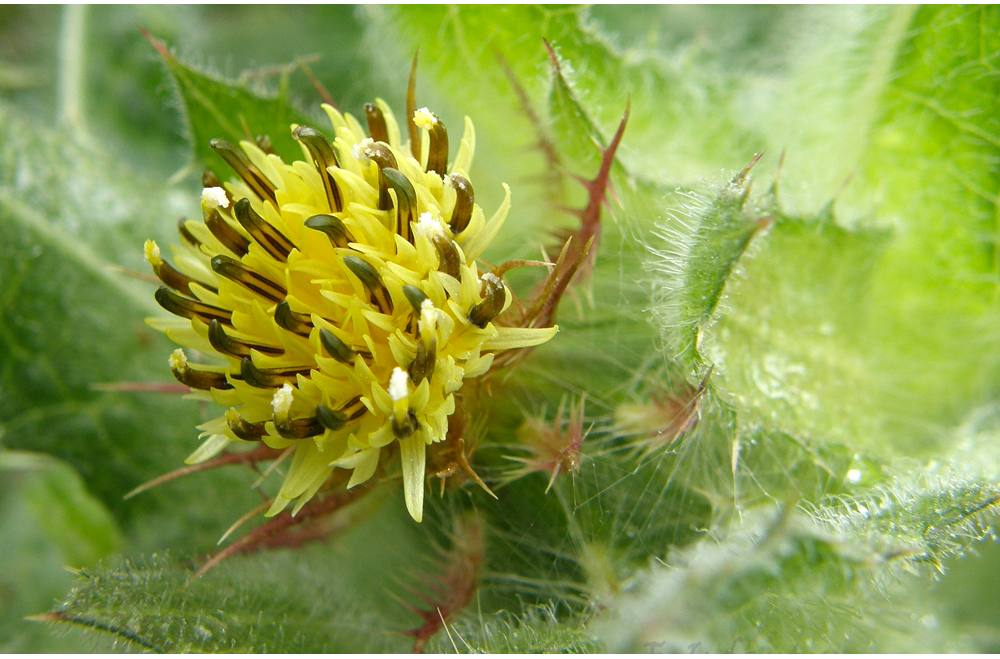Blessed thistle: properties and therapeutic use

Essentially considered by our ancestors as eupeptic, because it tones and facilitates digestion and incidentally febrifuge, the blessed thistle has broadened its field of action over time. Today, naturopaths recommend it for its antibiotic and anti-inflammatory properties and do not hesitate to prescribe it for its diuretic and anti-rheumatic properties.
The medicinal uses of the bitter principles of the blessed thistle or Cnicus benedictus have been known for centuries in both Ayurvedic medicine and European herbal medicine. Bitter drinks and potions have always been extracted from the plant, also known as the centaury blessed or wild saffron, to stimulate the appetite and promote digestion. It is believed that this annual plant of the compound or asteraceae family, native to the Mediterranean basin and West Asia, was introduced into Europe in the 16th century. At the time, it was cultivated mainly in monasteries. Moreover, blessed thistle, along with many other plants, herbs and spices, is used in the composition of the famous Benedictine liqueur made in Fécamp according to an old recipe of the Benedictine monks.
It was said that it could help fight the plague. It was also used, among other things, as a diuretic, but also to fight fever and malaria and as a topical application to treat infected wounds. Frederick III of Prussia was offered this plant, specially imported from India, to treat the violent migraines to which he was subjected.
SIS SECRET : ITS AMERICAN PRINCIPLES
Today, blessed charcoal is recognized and prescribed for its choleretic (which stimulates bile secretion) and cholagogue (which facilitates bile evacuation) actions. We now know that these digestive virtues are essentially due to the bitter principles it contains, in particular a sesquiterpenic lactone, cnicin. These bitter principles stimulate the salivary glands and trigger increased secretion of gastric juices, which promotes appetite, relieves dyspepsia (difficult and painful digestion) and headaches associated with liver congestion.
Blessed thistle also has an "antibiotic" action against bacteria Staphylococcus aureus (responsible for food poisoning), Streptococcus feacalis and Escherichia coli (responsible for urinary infections). With its diuretic properties, blessed thistle will help to eliminate uric acid, an excess of which can cause many joint disorders. For this reason, it is prescribed to relieve rheumatic pain and gout attacks. The plant finally has anti-inflammatory properties on its list of achievements and it could also heal wounds.
THE DIFFERENT THERAPEUTIC INDICATIONS
Appetite (loss of - light)
Blessed thistle naturally stimulates digestive juices and its bitter glycosides are recognized for helping to stimulate appetite, while acting as a general tonic for the entirety of the digestive tract. For this reason, the plant is often recommended when there is loss of appetite as a result of certain treatments or medications, and may also figure prominently in a comprehensive and multi-pronged approach to treating anorexia nervosa.
Boils & ulcers
Due to its astringent qualities, Blessed thistle is extremely adept at helping to slow down and prevent excessive bleeding. For this reason, it is often seen as one of the main ingredients in natural treatments and salves for boils, skin ulcers, carbuncles and other pus-filled skin infections. Finally, in alternative and complementary medicine circles, the herb is commonly used in the treatment of yeast infections and vaginal discharge of varying etiology.
Digestive conditions
As an aromatic bitter herb, blessed thistle naturally stimulates the secretion of saliva and gastric juices, and through this action, supports the entire digestive process while enhancing nutrient absorption. The herb’s bitter taste is said to trigger a reflex reaction that releases gastric juices into the stomach, especially those implicated in the digestion of fats. For this reason, blessed thistle is extremely useful for the treatment of GI symptoms such as dyspepsia, upset stomach, indigestion and flatulence.
Female health & galactagogue
Blessed thistle has a long history of use as a galactagogue herb. Today in both conventional and alternative medicine circles it is often recommended along with fenugreek, as the go-to to help stimulate milk production - blessed thistle is in fact recommended by the Canadian Breastfeeding Foundation. In addition, Blessed thistle is known to help balance women's fluctuating hormone levels, thereby helping to alleviate many hormonally-based symptoms such as dysmenorrhea (abdominal pain, cramping and others), breast tenderness and swelling, as well as general PMS and menopausal symptoms.
Respiratory allergies
Blessed thistle contains bitter compounds that decrease the thickness, while increasing the production of mucosal fluids – particularly those of the digestive and respiratory tracts. The plant also contains powerful astringent compounds that are highly antiseptic, aid in the dilation of peripheral blood vessels, and help shrink inflamed tissue which results from respiratory allergies, making the plant a potent and incredibly valuable addition to any complex approach to managing allergies.
THE POSSIBLE COMBINATIONS
Dong quai and wild yam, along with any other estrogenic plants can be used in combination with blessed thistle to treat menstrual difficulties and other conditions where a woman's hormones require to be brought back into balance. Fenugreek also combines exceedingly well with blessed thistle to help stimulate and support the production and flow of breast milk. To help tone and support the entire digestive system, milk thistle, which is hepatoprotective and has strong antioxidant and anti-inflammatory properties, as well as stimulates bile production, is considered very beneficial when combined with blessed thistle. Blessed thistle in fact, combines extremely well with most other plants that support the gastrointestinal tract.


Comments
Leave your comment